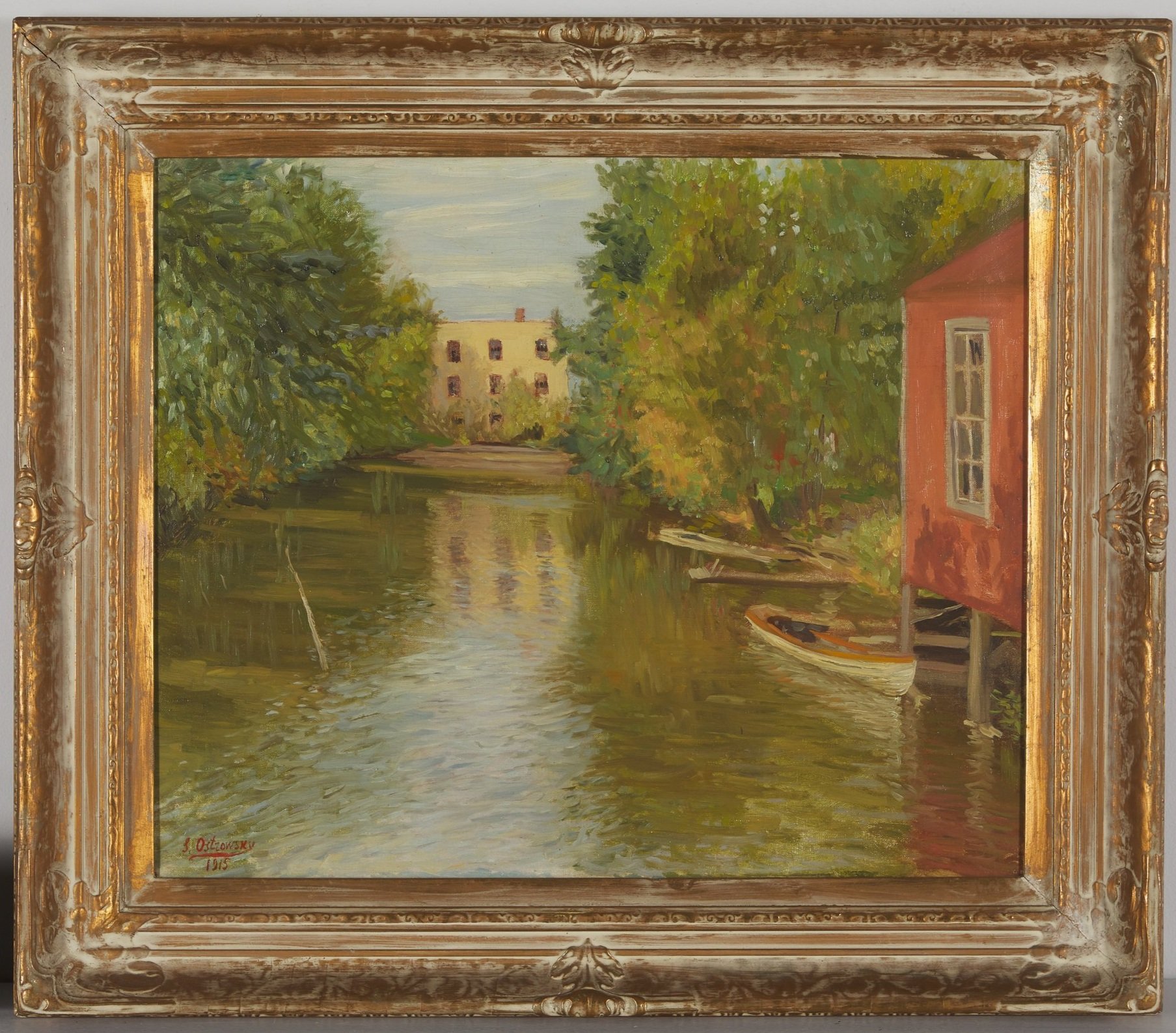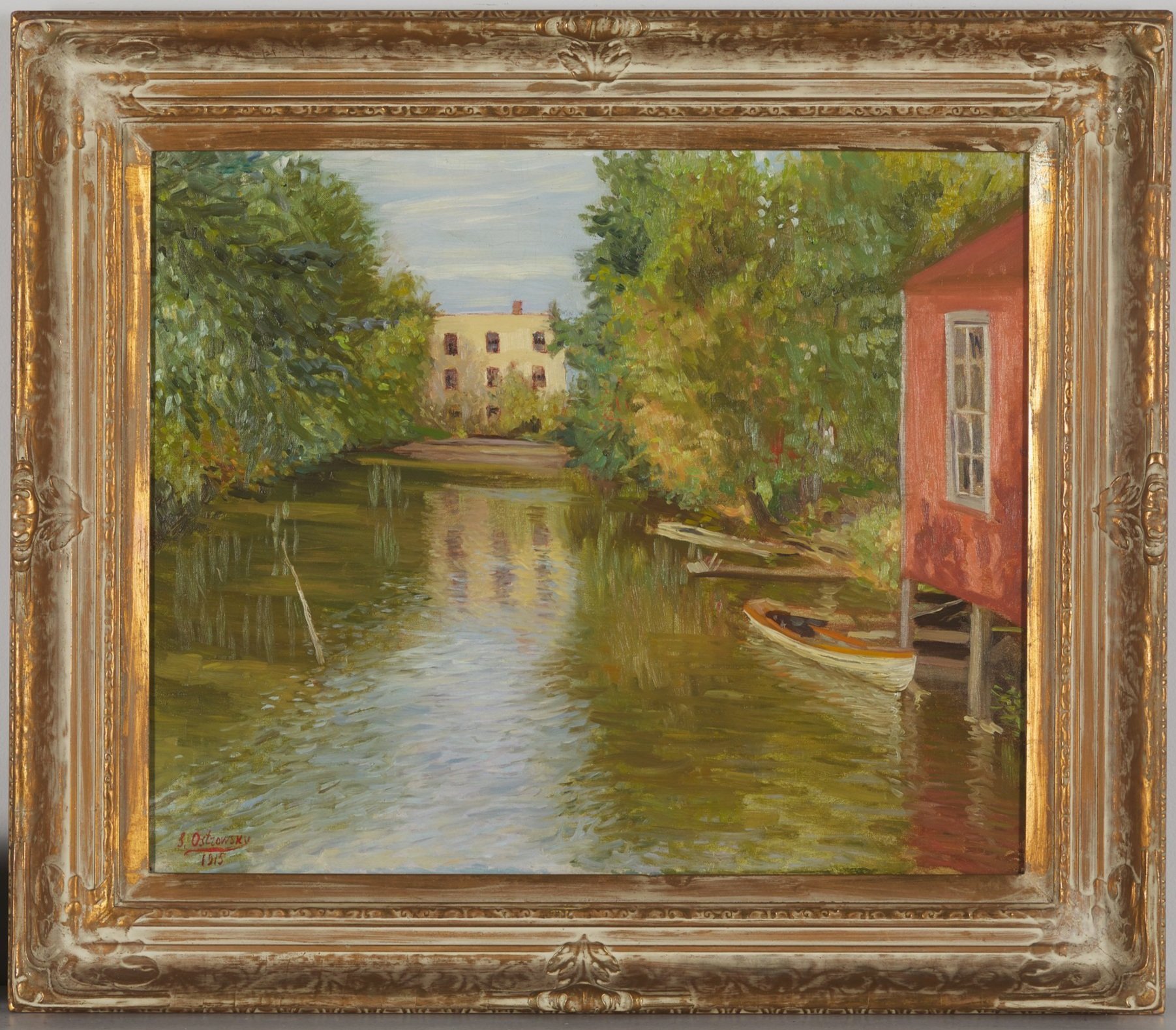River Scene, 1915, attributed to the Ukrainian-American painter Sam Ostrowsky, holds within its strokes the legacy of a talented artist and the tales of generations of owners. Purchased by the client's grandparents during one of their many travels, she remembers it hanging in their Minneapolis home and later adorning the walls of her parent's home. Ostrowsky, who immigrated to the United States in 1903 to live in Chicago and studied at the Art Institute of Chicago, added depth to its significance. "Several years ago, I had an appraiser look at it... The appraiser thought the picture may actually have depicted the Chicago River back in 1915. Although we don't know for sure, I have always loved the fact that the painting found its way back to Chicago."
River Scene, 1915, before treatment
River Scene, 1915, before treatment, verso
River Scene, 1915 measured at 27x31.25x3 inches, had weathered the years, acquiring its own tales. Yet, as it reached The Conservation Center, its journey toward rejuvenation unfolded. The examination revealed a medium weave canvas, displaying characteristics of linen and reflecting the artistry of oil paint applied with a moderate to thick hand. However, the passage of time had left its marks, including stretcher creases and age-related craquelure. There were pinholes at all four corners, inherent to the painting. The upper right corner had rippling and a corner draw, while a 1/2" round dent was present in the upper left quadrant. A tear, measuring approximately 1/8", was present near the lower right corner on the turnover edge. The painting was coated with a discolored and tenacious satin natural resin varnish, distorting the paint colors beneath.
River Scene, 1915, before treatment, unframed
River Scene, 1915, verso before treatment, unframed
The frame, a composition of wood, compo, gesso, toner, and imitation gold leaf, echoed the painting's condition with open miters, minor losses, and dents throughout. Two of the miter corners were open, and there was a minor loss to the compo at the top right miter. The frame's finish appeared original and intentionally distressed but was also coated with a moderate layer of surface grime with heavy tape residue on the back. Much like the painting, the frame had weathered the years and now had age-related conditions issues.
River Scene, 1915, detail of frame before treatment, showing open miter
River Scene, 1915, detail of frame before treatment, showing open miter
For Rebecca Vodehnal, Associate Paintings Conservator, Josh McCauley, Senior Conservator of Objects and Frames, and Suz Evans, Associate Conservation Framer, the conservation journey began. First, Rebecca consolidated paint loss as necessary- primarily in the upper left corner at the area of deformation. Then, the deformations in the corners were flattened with light moisture and weights. The tear was addressed with conservation adhesive and bridging threads to mend the areas of damage. The upper right corner was restretched to address the deformations. Missing stretcher keys were then replaced.
River Scene, 1915, before treatment, under UV light examination
River Scene, 1915, before treatment, under raking light
The surface grime was delicately cleaned so Rebecca could remove the discolored varnish layer, revealing the detail of the artist's brushwork. Areas of loss were filled with conservation-appropriate materials, and a coat of varnish was applied by brush to saturate the paint layer. Inpainting was then carried out in areas of loss using reversible conservation paints before a final coat of spray varnish was to integrate the surface finish.
River Scene, 1915, after treatment, unframed
River Scene, 1915, verso after treatment, unframed
Simultaneously, Josh McCauley began treatment of the frame. The frame was cleaned to remove particulates, surface grime, and the tape residue on the verso. Then, the miters were stabilized and filled, and the losses to the gesso and compo were consolidated. Large areas of loss were filled with carvable epoxy, and smaller areas of gesso loss were filled with traditional gesso. Josh addressed large areas of loss to the finish where necessary, filling with red bole and water gilding that was toned to integrate with the surrounding surface. Smaller areas of loss were inpainted to emulate the surrounding surface. The painting was then reinstalled into the frame to conservation standards by Suz Evans, with an archival backing board attached to the reverse to provide additional protection.
River Scene, 1915, verso after treatment, reframed
The conservation unveiled details unseen before. Once mistaken for a scratch, the reflection in the river emerged as a submerged detail, a part of Ostrowsky's composition. "I decided to have it conserved as it was difficult to see the details in the painting, and I thought it had been scratched. Following the conservation, the details in the river were obvious: the "scratch" was a reflection in the water that was part of the underwater details in the river that had not been visible before."
The colors, now radiant, breathed life into the living room of the painting's owner, harmonizing with a collection of artworks inherited from her parents and grandparents, just like River Scene, 1915. A testimony to Ostrowsky's skill and the dedication of the conservators, this revived painting now resonates with renewed vigor, a testament to the enduring beauty of art.
River Scene, 1915, after treatment and reframing
River Scene, 1915, back on display in the living room of the owner’s home

















